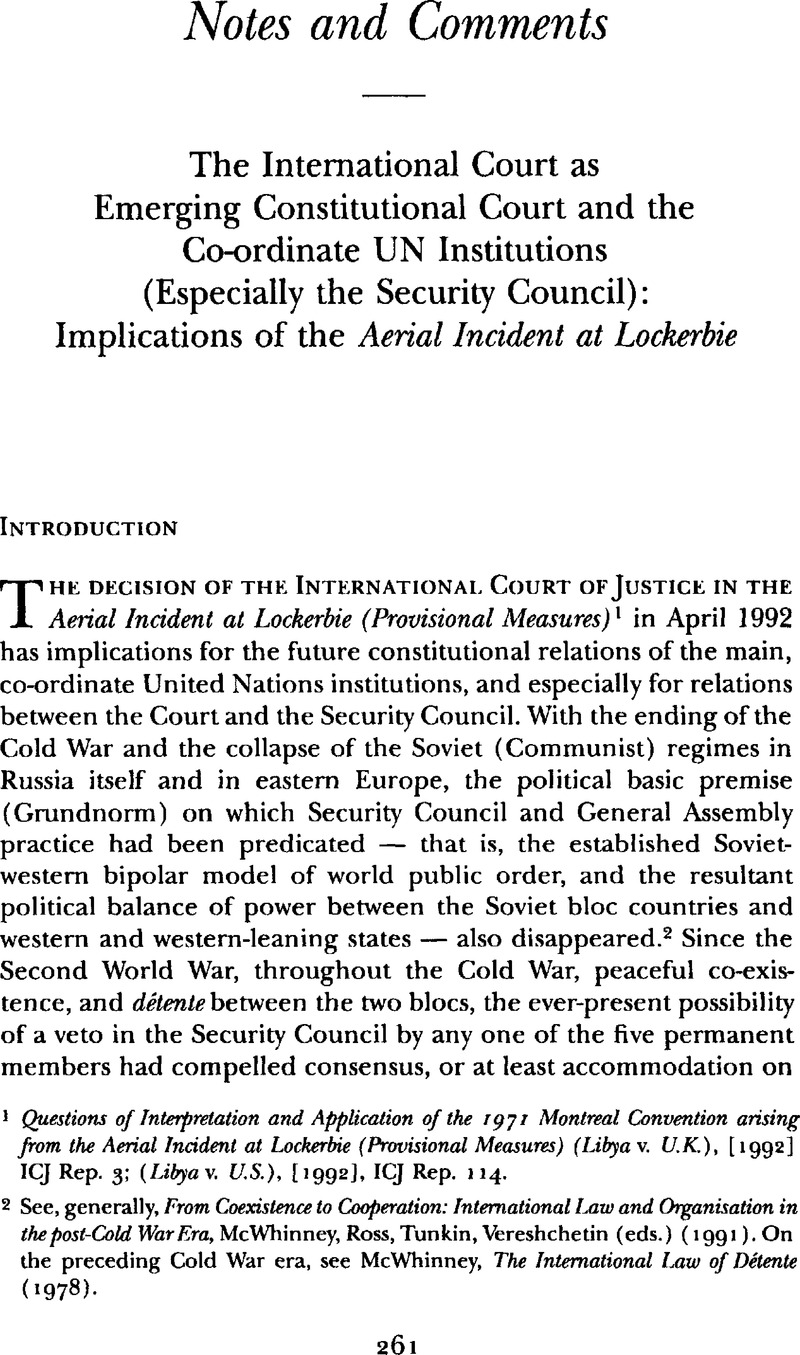Published online by Cambridge University Press: 09 March 2016

1 Questions of interpretation and Application of the 1971 Montreal Convention arising from the Aerial Incident at Lockerbie (Provisional Measures) (Libya v. U.K.), [1992] ICJ Rep. 3; (Libyav. U.S.), [1992], ICJ Rep. 114.
2 See, generally, From Coexistence to Cooperation: International Law and Organisation in the post-Cold War Era, McWhinney, Ross, Tunkin, Vereshchetin (eds. ) ( 1991 ). On the preceding Cold War era, see McWhinney, , The International Law of Détente (1978).Google Scholar
3 UN G.A. Res. 377 A(V), Nov. 3, 1950 (adopted by a vote of 52 to 5, with 2 abstentions.)
4 1 Cranch 137 ( 1803).
5 Legal Consequences for States of the Continued Presence of South Africa in Namibia (South West Africa) Notwithstanding Security Coundl Resolution 276 (1970), Advisory Opinion, [1971] ICJ Rep. 16.
6 See generally McWhinney, , Judicial Settlement of International Disputes 142–47, 157–58. (1991).Google Scholar
7 Libyav. U.K., [1992] ICJ Rep. 3; Libya v. U.S.., [1992] ICJ Rep. 114.
8 Aerial Incident of 3 July 1988 ( Islamic Republic of Iran v. U.S.A.), Order of 13 December 1989, [1989] ICJ Rep. 132.
9 Montreal Convention, 1971, Article 7. See, generally McWhinney, , Aerial Piracy and international Terrorism: The illegal Diversion of Aircraft and International Law 45 et seq. (2nd rev. ed., 1987).Google Scholar
10 Time, Apr. 19, 1992; quoted in Le Monde (Paris), Apr. 17, 1992; republished in Die Zeit (Hamburg), May 1, 1992.
11 Libyav. U.K., [1992] ICJ Rep. 3, at 3–16 (the detailed citations that follow are from this case); Libya v. U.S.., [1992] ICJ Rep. 114, at 1 14–28.
12 [1992] ICJ Rep. 3, 15 (para. 39).
13 Ibid., 15 (para. 40).
14 Ibid., 15 (para. 41).
15 Ibid., 17–19.
16 Ibid., 17.
17 Ibid.
18 Ibid., 19.
19 Ibid.
20 Nicaragua v. U.S.., Merits, Judgment, [1986] ICJ Rep. 14.
21 McWhinney, supra note 6 at 9, 142–47, 157–58.
22 [1992] ICJ Rep. 3, 26.
23 Ibid.
24 Nuclear Tests (Australia v. France), Judgment of 20 December 1974, [1974] ICJ Rep. 253.
25 Ibid.
26 [1992] ICJ Rep. 3,26.
27 Ibid., 29–32, especially at 31.
28 See, e.g., Wengler, , “International Law and the Concept of a New World Order,” in Federalism-in-the-Making: Contemporary Canadian and German Constitutionalism, National and Transnational, McWhinney, , Zaslove, , Wolf, (eds.) 122–27 (1992)Google Scholar; Lauterpacht, , Aspects of the Administration of International Justice 37–48 (1991).Google Scholar